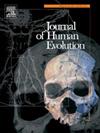First articulating os coxae, femur, and tibia of a small adult Paranthropus robustus from Member 1 (Hanging Remnant) of the Swartkrans Formation, South Africa
IF 3.1
1区 地球科学
Q1 ANTHROPOLOGY
引用次数: 0
Abstract
Since paleontological work began there in 1948, Swartkrans (South Africa) has yielded hundreds of Early Pleistocene hominin fossils, currently attributed to (in ascending order of quantity) cf. Australopithecus africanus, Homo spp., and Paranthropus robustus. The bulk of that large sample comprises craniodental remains, with (mostly fragmentary) postcranial materials being much less abundant at the site. In that context, our announcement here of the first articulating partial os coxae, nearly complete femur, and complete tibia of a young adult hominin (SWT1/HR-2), excavated from the <2.3 to >1.7-million-year-old Hanging Remnant (Member 1) of the Swartkrans Formation, represents an important addition to the understanding of hominin postural and locomotor behavior in Early Pleistocene South Africa. We provide qualitative and quantitative descriptions and initial functional morphological interpretations of the fossils, based mostly on external bone morphology. Epiphyseal fusion data, element dimensions, the crural index, and live body stature and mass estimates that we provide all indicate that SWT1/HR-2 is one of the smallest known adult hominins in the fossil record. We discuss the paleobiological implications of these findings in relation to our taxonomic diagnosis of SWT1/HR-2 as representing P. robustus.
南非Swartkrans组第1成员(悬挂残余物)中一个小型成年副粗壮人的髋部、股骨和胫骨
自从1948年在那里开始古生物学工作以来,斯瓦特克朗斯(南非)已经发现了数百块早更新世的古人类化石,这些化石目前被归类为(按数量由高到低)非洲南方古猿、智人和傍人粗壮人。这个大样本的大部分是颅齿残骸,(大部分是碎片)颅后材料在现场的数量要少得多。在此背景下,我们在此宣布,从距今230万至170万年前的Swartkrans组悬挂遗迹(成员1)中出土的一个年轻成年人族(SWT1/HR-2)的第一个可连接的部分股骨、几乎完整的股骨和完整的胫骨,为了解早更新世南非人族的姿势和运动行为提供了重要的补充。我们提供化石的定性和定量描述和初步功能形态学解释,主要基于外部骨骼形态学。我们提供的骨骺融合数据、元素尺寸、脚指数、活体身高和质量估计都表明,SWT1/HR-2是化石记录中已知最小的成年人族之一。我们讨论了这些发现的古生物意义与我们的分类诊断SWT1/HR-2代表壮种。
本文章由计算机程序翻译,如有差异,请以英文原文为准。
求助全文
约1分钟内获得全文
求助全文
来源期刊

Journal of Human Evolution
生物-进化生物学
CiteScore
6.30
自引率
15.60%
发文量
104
审稿时长
3 months
期刊介绍:
The Journal of Human Evolution concentrates on publishing the highest quality papers covering all aspects of human evolution. The central focus is aimed jointly at paleoanthropological work, covering human and primate fossils, and at comparative studies of living species, including both morphological and molecular evidence. These include descriptions of new discoveries, interpretative analyses of new and previously described material, and assessments of the phylogeny and paleobiology of primate species. Submissions should address issues and questions of broad interest in paleoanthropology.
 求助内容:
求助内容: 应助结果提醒方式:
应助结果提醒方式:


